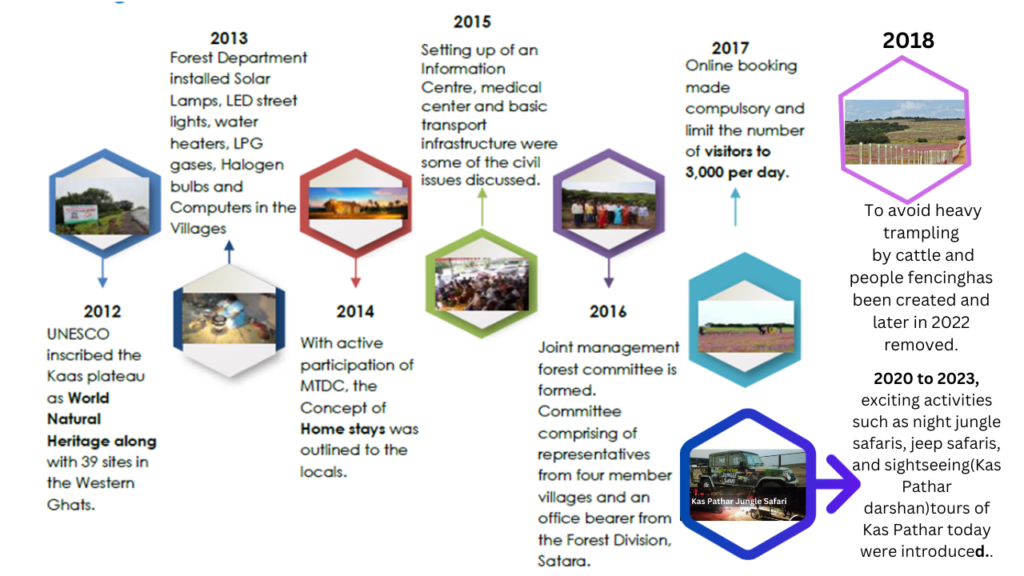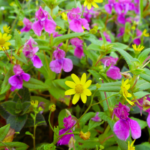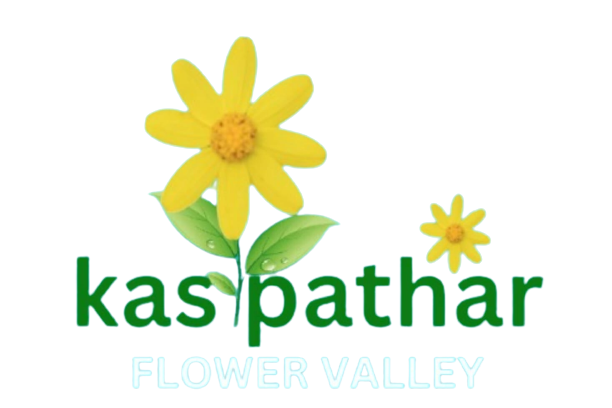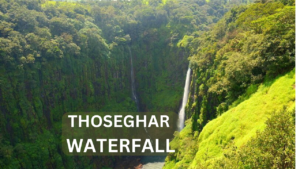Introduction
Kaas Plateau, also known as Kas Pathar. Kas Pathar today is located in the Satara district of Maharashtra state in India. It is a renowned biodiversity hotspot in the Western Ghats, which is locally referred to as Sahyadri.

The Western Ghats stretches over a length of 1600 kilometres and covers an area of 140,000 square kilometres. In 2012, during the World Heritage Committee held in Saint Petersburg, Russia, the Kaas Plateau, along with 39 other sites, was designated as a UNESCO World Natural Heritage Site.
In 2012, during the World Heritage Committee in Saint Petersburg, Russia, the Kaas Plateau was designated as a UNESCO World Natural Heritage Site, along with 39 other locations.
This beautiful place is perched on top of a hill and transforms into a stunning
“valley of flowers” during the monsoon season, specifically from August to early October. Found in the Satara district of Maharashtra, it is positioned at 17º42’ – 17º45’N and 73º47’ – 73º56’E, with an elevation of 1200 meters and covering an area of around 10 sq km.
The Biodiversity Heritage of Kas Pathar today

There are a couple of stories behind the name ‘Kaas’ for the plateau. One story is that Kas Pathar today got its name from the Kaasa tree, which is found in the surrounding forests. Another story is that ‘Kaasa’ also means a lake in the regional language, and the presence of a major lake on the plateau could have influenced its name.
The plant and animal life in Kas Pathar is truly one-of-a-kind and specific to this area. There are over 850 types of flowering plants found in the Kaas Plateau, with 624 of them being listed in the Red Data Book 2. Out of these, 39 species can only be found in the Kaas Region.
Timeline of Kas Pathar today since its inscription as World Natural

2012-The Kaas plateau was recognized by UNESCO as a World Natural Heritage site, along with 39 other locations in the Western Ghats.
2013-The Forest Department took initiatives to improve the villages by installing solar lamps, LED street lights, water heaters, LPG gases, halogen bulbs, and computers.
2014- The Maharashtra Tourism Development Corporation (MTDC) worked with the locals to introduce the concept of homestays.
2015- Discussions on civil issues, resulting in the establishment of an Information Centre, medical centre, and basic transport infrastructure.
2016 -A joint management forest committee was formed, consisting of representatives from four member villages and a Forest Division office bearer from Satara.
2017-Online booking became mandatory in 2017, with a limit of 3,000 visitors per day.
2018- Measures were taken to prevent damage caused by cattle trampling, including the installation of fences, which were later removed in 2022 due to technical issues.
Finally, from 2020 to 2023, exciting activities such as night jungle safaris, jeep safaris, and sightseeing(Kas Pathar darshan)tours of Kas Pathar today were introduced.
Tourism of Kas Pathar today:
Ever since the Kaas Plateau was declared a UNESCO World Heritage Site in 2012, countless tourists have been flocking to Kas Pathar today.
The Committee created a unique website to offer tourists all the details about the plateau and to allow them to sign up for their upcoming trips. Right now, it’s mandatory to book online for Saturdays, Sundays, and Public Holidays. The officials have permitted ticket sales on the website, but they have limited the number of daily visitors to 3,000. In case of a large crowd or traffic congestion, tourists are kept within Satara city with the assistance of the police and volunteers.
Revenue Allocation:

The money collected from visitors throughout the season is utilized for the upkeep and wages of the villagers who work there in different capacities. The overall income obtained is divided as follows:
1- 50% of the total income is allocated for the improvement of Kas Pathar today.
2- 30% of the total income is utilized for the progress of six villages, which primarily involves repairing roads and providing water supply. It is also used for managing and meeting the infrastructure requirements of schools in these villages.
3- 20% of the total income is saved as a fixed deposit in the IDBI bank.
Management of Kaas Plateau:
The Forest Department, along with the Joint Forest Management Committee (JFMC) and dedicated local villagers, are currently collaborating to preserve, protect, and take care of Kas Pathar today. The management of Kaas has been divided into six different sections, with each section having its own appointed leader.
Water supply: There is a dedicated team in charge of all water-related activities. To ensure hygiene and sanitation in Kas Pathar today, water tankers are brought in from Satara to supply water for the toilets during the busy tourist season.
Waste management: A dedicated team has been appointed to manage solid waste and sewage waste disposal for proper sanitation.
Security (Day and Night Shift): The entire plateau, spanning around 1,800 hectares, is guarded by a team of 12 people who work in shifts to ensure security.
Guide: The committee has encouraged local villagers to explore employment opportunities in Kas Pathar today, particularly as tourist guides and part of the maintenance team.
Parking: Please note that parking of cars and other vehicles is strictly prohibited on the plateau. However, a designated parking space is approximately 500 meters away, where visitors can park their vehicles. Additionally, the State Transport has arranged mini buses to transport visitors to and from the site at a minimal cost.
Office: A temporary facility has been set up for administrative purposes, record-keeping, and managing online booking data.
Community Development on Kas Pathar today
The JFMC received a proposal from the Gram Sabha of six villages, and since then, 30% of the revenue has been allocated to developing these villages. Before the start of each season, the villagers fill out employment forms, and based on their skills and capacities, they are assigned different types of work.
Non-profit organizations have organized workshops for women in the villages to teach them how to make homemade food products, providing additional employment opportunities.
The JFMC is collaborating with the local community to identify challenges and find solutions in various areas, such as creating more job opportunities for the villagers throughout the year and expanding tourist sites. They have also designated parking spaces for tourist vehicles, and the State Transport Department has provided minibuses to transport tourists to the flowering site, resulting in a significant reduction of 80-90% in pollution.
Progress achieved by JFMC Kas Pathar today
1. On Saturdays, Sundays, and public holidays, it is mandatory to book your tickets online. However, you can still purchase tickets at the onsite counter, but please note that the number of visitors allowed per day is limited to 3,000.
2. For your convenience, You’ll find dustbins placed at regular intervals and toilets available on the plateau.
3. The plateau is equipped with 32 water holes specifically designed for animals to quench their thirst.
4. To efficiently manage the tourists and avoid chaos in the parking area, walkie-talkies were utilized.
5. To preserve the natural beauty of the plateau, vehicles are not permitted. Instead, controlled nature trails are conducted on designated pathways within the tourist zones.
- On weekdays, the number of tourists does not exceed 3,000, unless individuals travelling from long distances are allowed to purchase counter tickets for their visit.
Challenges yet to overcome:
1. The absence of security and checking posts on certain routes to Kaas Plateau has posed a challenge in accurately tracking the number of tourists visiting the area.
2. During the off-season, there is a lack of employment opportunities.
3. The recent surge in tourism has become a major concern, not just for the plateau but also for the surrounding areas.
4. The accumulation of food waste, plastic bottles, plates, and bags has become a prevalent issue at Kaas Lake.
Kas Pathar online booking contact number
Since 2023, the entry fee on Kas Plateau has been revised by the Joint Forest Management Committee.
- The entry fee for the park is Rs.150 per person. If you have made an online booking, please make sure to bring a printed entry ticket as mobile screenshots will not be accepted. However, children below 12 years of age do not have to pay any entry fee.
- For school and college students, there is a special facility available at a discounted rate of Rs.40 per person. However, it is mandatory to bring a letter from the school or college principal. Please note that this facility is not available on Saturdays and Sundays.
- If you wish to enjoy a bicycle ride from Rajmarg to Kumudini Lake, the fee is Rs.50 per hour. For a guided tour, the fee is Rs.100 per hour and one guide is provided for every ten people. Please remember that online booking is compulsory for both of these activities.
If you have any queries or need further information, you can contact the following people: –
- Somnath Jadhav: 9422592035
- Dattatray S. Kirdat: 8698993553
- Dnyaneshwar Akhade: 8600523113
- Vitthal Kadam: 8459876484
Responsible Tourism and Preservation for Kas Pathar today:
It is crucial for the villagers in the area to be aware of and appreciate the beauty of the Kaas Pathar. They should also understand the importance of preserving this delicate ecosystem and ensure that their activities do not cause any harm. Additionally, waste management is a major concern in Kas Pathar. It is important to have an effective waste management system that not only focuses on waste disposal but also addresses the root cause of waste generation. One possible solution could be declaring Kaas as a ‘No single-use plastic zone’.
Why the plateau is named ‘Kaas’?

One story is that Kas Pathar today got its name from the Kaasa tree, which is found in the surrounding forests. Another story is that ‘Kaasa’ also means a lake in the regional language, and the presence of a major lake on the plateau could have influenced its name.
Is a sanitization facility available in Kas Pathar Satara?
The Joint Forest Management Committee has provided temporary toilet dustbin facilities.
Has the entrance fee to Kas Plateau been changed?

Since 2023, the entry fee on Kas Plateau has been revised by the Joint Forest Management Committee. Now it is 150 Rs per person




